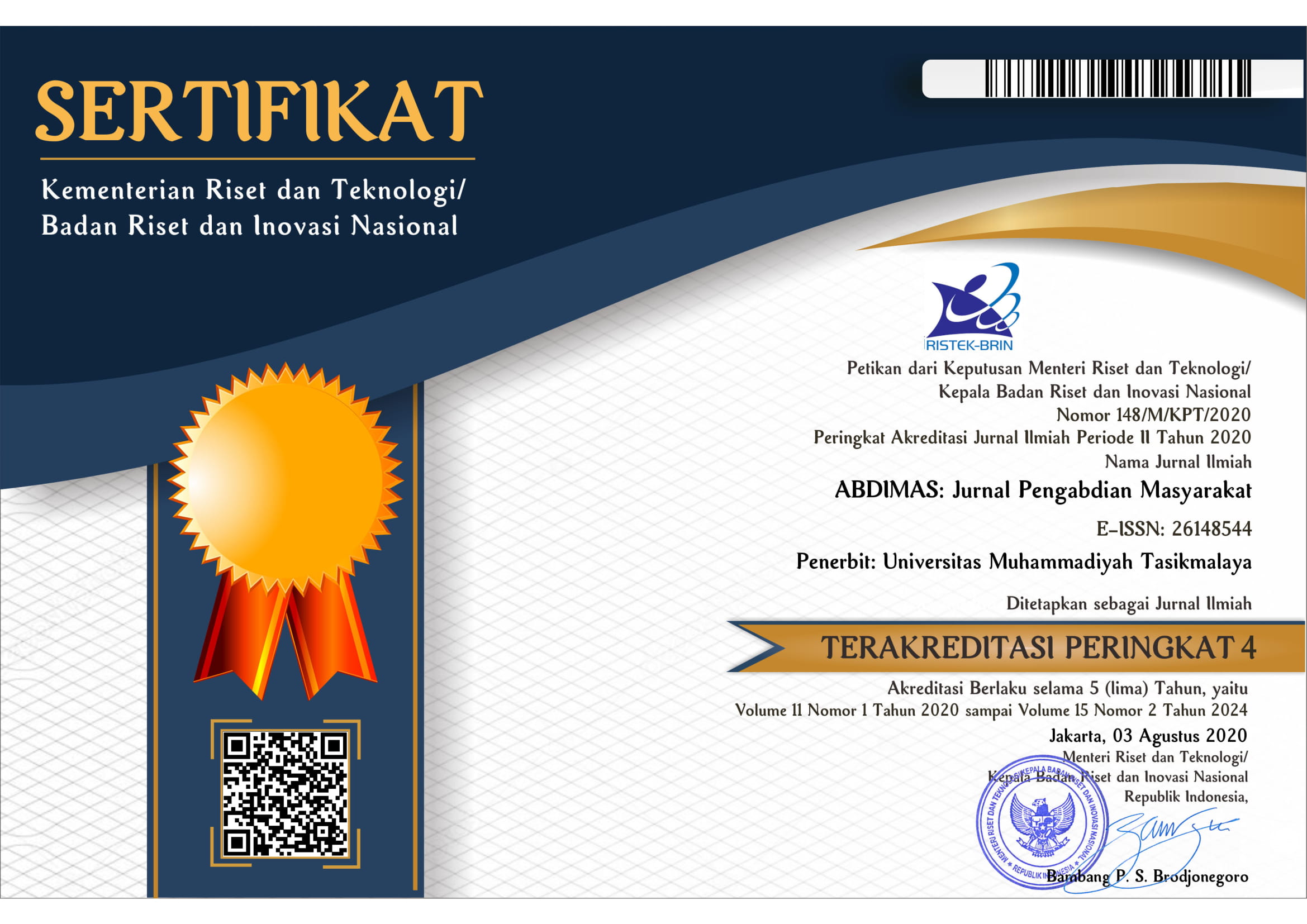Efforts to Prevent Eye Fatigue Through Evaluation of Lighting Intensity (Illumination Level) in the Library at Muhammadiyah University Lamongan
DOI:
https://doi.org/10.35568/abdimas.v7i3.4821Keywords:
Lighting System, Fatigue, IoTAbstract
The Muhammadiyah group has implemented community service programs (PKM) in collaboration with the Universitas Muhammadiyah Lamongan (UMLA) Library. In order to comply with SNI 03-6197-2000 regarding energy conservation in lighting systems, the PKM activity aims to measure and create a contour map of the lighting intensity level (also known as illumination level) in the UMLA library space, increase target partners' knowledge regarding lighting intensity (also known as illumination level) in the work space and its relationship to eye fatigue, and implement technology in the form of an IoT integrated room lighting system. The target partners will be fully involved in all activities, including FGD (First Measurement of Lighting Levels in Library Spaces), counseling regarding lighting intensity (Illumination Level) in work spaces and its relationship to eye fatigue, and the design and implementation of sensor and IoT based room lighting systems. The method for implementing community service activities is a participatory approach. The Muhammadiyah Lamongan University Library Institute, the community service partner, was able to accurately assess the illumination in the interpretation library room by means of a number of completed community service projects. We may conclude that the UMLA library's light intensity, which is ≥ 300 lux, satisfies the SNI criterion.
Downloads
References
Chasanah, U., & Widodo, A. (2023). Analysis of Classroom Light Intensity as an Indicator of Effects of Eyestrain in the Effectiveness of the Learning Process at the Universitas Muhammadiyah Lamongan. Jurnal Pendidikan Fisika Dan Keilmuan (JPFK), IX(Ii).
Datangeji, R. U., Warsito, A., Sutaj, H. I., Lapono, L. A. S., Fisika, P. S., Sains, F., Cendana, U. N., & Adisucipto-penfui, J. (2019). KAJIAN DISTRIBUSI INTENSITAS CAHAYA PADA FENOMENA DIFRAKSI CELAH TUNGGAL DENGAN METODE BAGI DUA DAN METODE NEWTON RAPHSON. Jurnal Fisika Sains Dan Aplikasinya, 4(2), 56–69.
I Wayan Merta, I Wayan Mudiarsa Darmanika, & Rauh Jaril Gifari. (2022). Penanggulangan Banjir melalui Biopori sebagai Bentuk Pemberdayaan Masyarakat Guna Mewujudkan Desa Siaga Bencana. Jurnal Pengabdian Magister Pendidikan IPA, 5(2), 53–57. https://doi.org/10.29303/jpmpi.v5i2.1466
Kurniasih, S., Saputra, O., Fakultas, A., Universitas, T., & Luhur, B. (2019). EVALUASI TINGKAT PENCAHAYAAN RUANG BACA PADA PERPUSTAKAAN UNIVERSITAS BUDI LUHUR, JAKARTA. 73–79.
Mayasari, E. D., Firdaus, T. P., Rahman, M. H., Jati, S. N., H, E. W. D., Pratama, M. Y., Tanjung, M. R., & Sutriyono, E. (2020). Sosialisasi Pembuatan Peta Desa Menggunakan Aplikasi Sistem Informasi Geografis di Desa Tanjung Kurung, Kabupaten Ogan Komering Ulu, Sumatera Selatan. Jurnal Pengabdian Community, 2(2), 40–44.
Magero, C. V., Nyamari, J., & Mutisya, R. (2023). Visual Comfort and Discomfort in Public Boarding Secondary Schools in Nairobi City County, Kenya. East African Journal of Health and Science, 6(1), 62–84. https://doi.org/10.37284/eajhs.6.1.1123
Osemudiamen, E. A., & Stanley, E. O. (2023). Assessment Of Illuminance and Related Health Effects in Some Departments Within a University Environment. Dutse Journal of Pure and Applied Sciences, 9(2b), 309–318. https://doi.org/10.4314/dujopas.v9i2b.32
PAMUNGKAS, M., HAFIDDUDIN, H., & ROHMAH, Y. S. (2015). Perancangan dan Realisasi Alat Pengukur Intensitas Cahaya. ELKOMIKA: Jurnal Teknik Energi Elektrik, Teknik Telekomunikasi, & Teknik Elektronika, 3(2), 120. https://doi.org/10.26760/elkomika.v3i2.120
Putra, R. N. G., Nugraha, A. E., & Herwanto, D. (2021). Analisis Pengaruh Intensitas Pencahayaan terhadap Kelelahan Mata Pekerja. Jurnal Teknika, 15(1), 81–97.
Rezka Adi, A. (2019). Optimalisasi Pencahayaan Alami Pada Ruang Perpustakaan Universitas Islam Negeri Walisongo Semarang. Jurnal Arsitektur Komposisi, 13(1), 35–44.
Salehuddin, M., & Latupeirissa, H. F. (2017). Evaluasi Desain Pencahayaan Interior Pada Ruang Pertemuan Publik Berdasarkan Nilai Intensitas Pencahayaan. IX(2), 73–77.
Tina Hernawati Suryatman, O. H. (2021). Perbaikan Intensitas Cahaya Pengguna Komputer dengan Pendekatan di PT. UJT Indonesia. JT : Jurnal Teknik P-ISSN: 2302-8734 E-ISSN: 2581-0006 Vol. 10 No. 1 Th. 2021, 10(9), 59–73. Kelelahan Mata, Intensitas Pencahayaan, Chi Square Test, Desain Pencahayaan, Kantor PT. UJT Indonesia%0APENDAHULUAN












